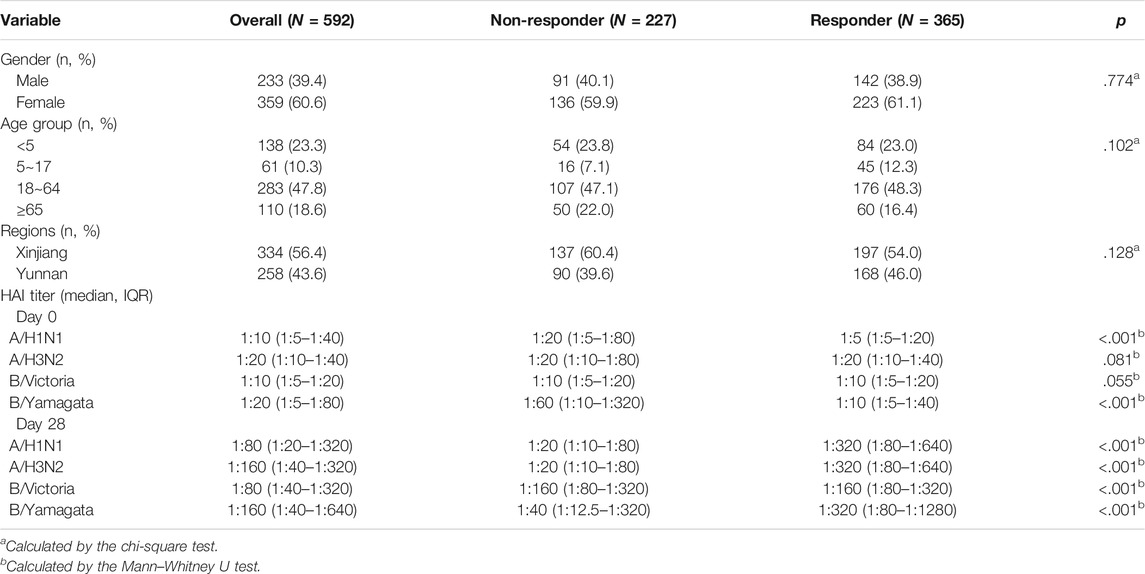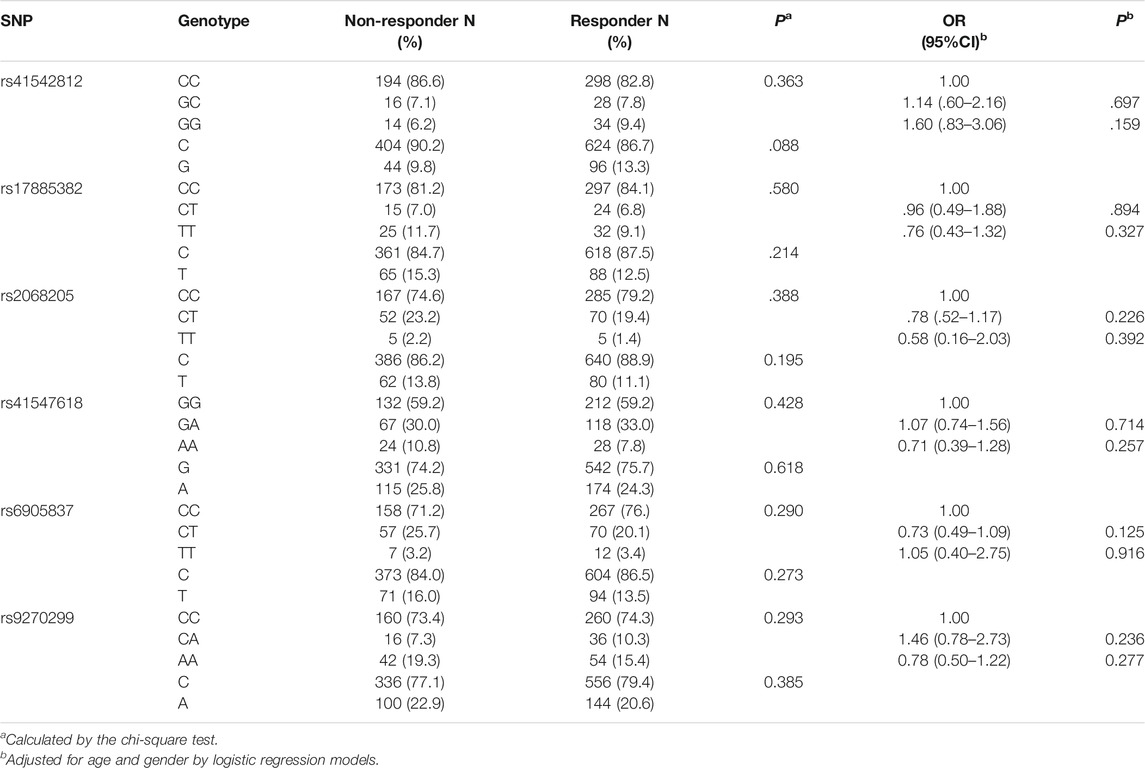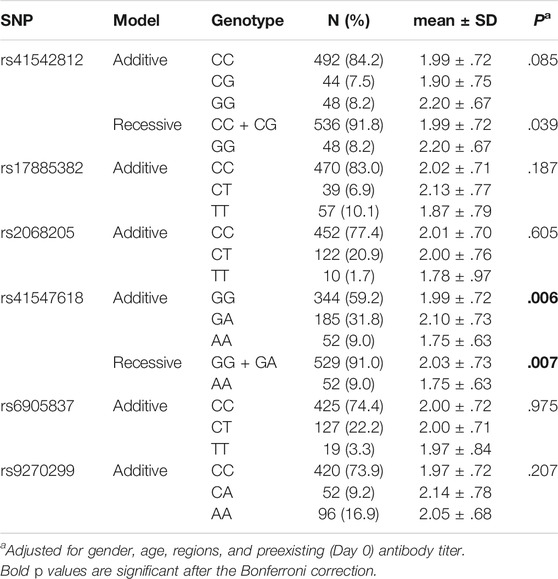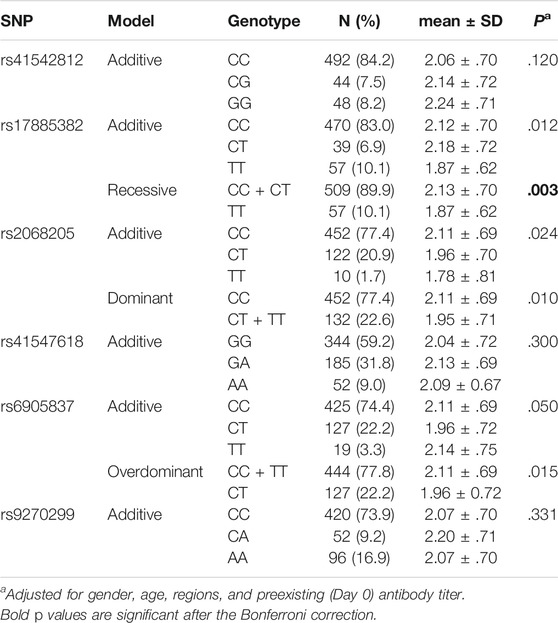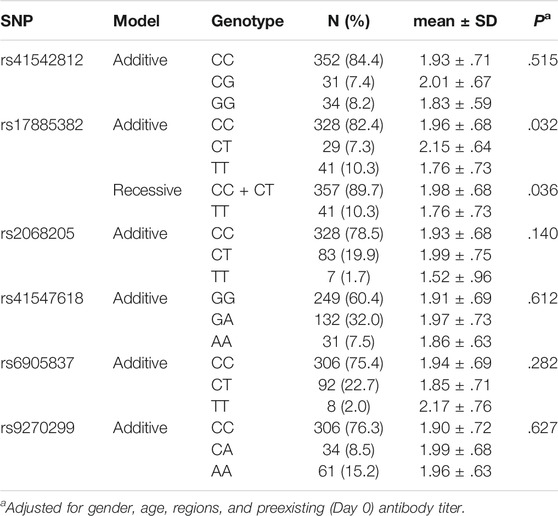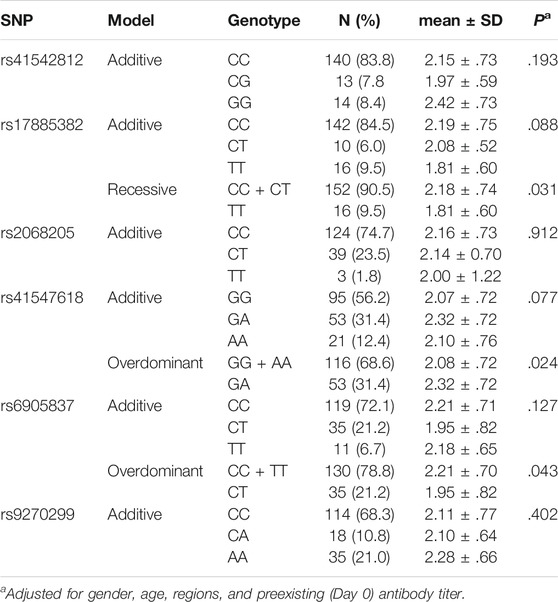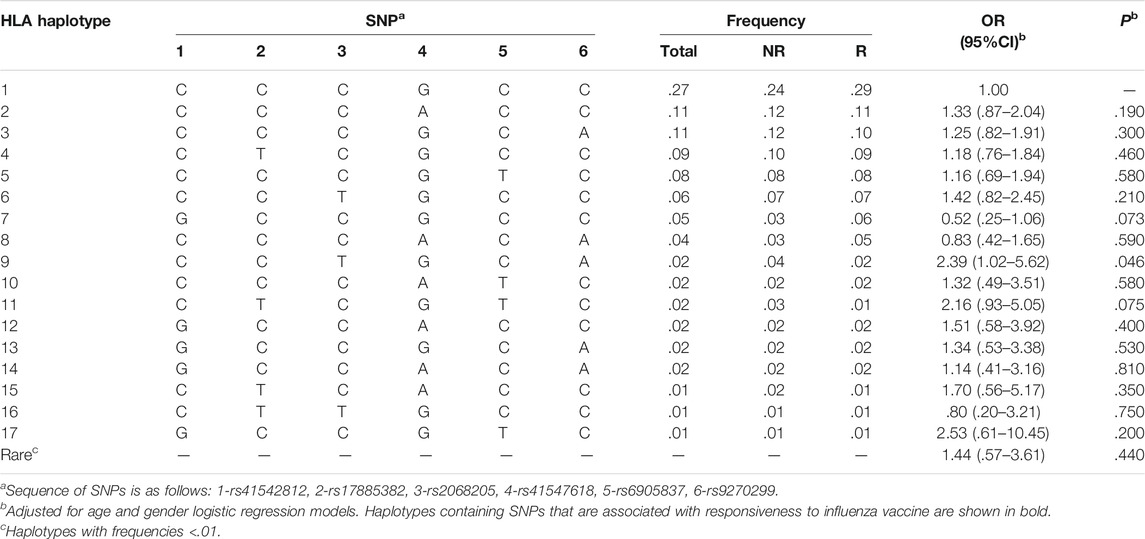- 1School of Public Health (Shenzhen), Shenzhen Campus of Sun Yat-sen University, Shenzhen, China
- 2Institute for Viral Disease Control and Prevention, Chinese Center for Disease Prevention and Control, Beijing, China
Background: The annual death associated with seasonal influenza is 290,000–650,000 globally, which can be effectively reduced by influenza vaccination. However, the protective hemagglutination inhibition (HAI) antibody response to influenza vaccine is affected by many factors, among which single nucleotide polymorphisms (SNPs) in the human leukocyte antigen (HLA) region can alter the antigen-presenting function of the HLA molecule, thus influencing the process of antibody mounting against vaccine antigen.
Methods: Healthy subjects of the Han nationality were recruited and received seasonal trivalent influenza vaccine. Paired serum samples collected on and approximately 28 days after vaccination were tested in parallel by HAI assays. HLA alleles related to the immune response to influenza vaccine reported in the previous literature were summarized, and six corresponding tag SNPs were selected and genotyped using the MassARRAY technology platform.
Results: The effects of HLA SNPs on HAI antibody response to influenza vaccine varied with different vaccine antigens. The AA genotype of rs41547618 was correlated with low A/H1N1-specific antibody titer compared with the GG + GA genotype (p = .007). The TT genotype of rs17885382 was correlated with low A/H3N2-specific antibody titer compared with the CC + CT genotype (p = .003). In addition, haplotype consisting of rs41542812—rs17885382—rs2068205—rs41547618—rs6905837—rs9270299—CCTGCA was correlated with non-responsiveness to influenza vaccine (OR = 2.39, 95% CI = 1.02–5.62).
Conclusion: HLA SNPs were associated with HAI antibody response to influenza vaccine, which can help in a better understanding of the varied responsiveness to influenza vaccine in the population.
1 Introduction
Influenza remains one of the main threats to public health worldwide, resulting in seasonal epidemics with 290–650 thousand deaths annually (Iuliano et al., 2018). Vaccination was proved to be one of the most effective measurements to reduce the infection risk of influenza virus by 40%–60% in the overall population during the season when the vaccine strains well-matched the circulating ones (Centers for Disease Control and Prevention, 2021). However, influenza vaccine is not universally protective, and there are still some individuals who fail to mount a protective serologic response to the vaccine. The immune response to influenza vaccine may be influenced by host-related factors such as age, gender, health condition, and genetic variants (Powers and Belshe, 1993; Castrucci, 2018; Scepanovic et al., 2018).
A few studies have found that genetic variants in human leukocyte antigen (HLA), cytokine, and cytokine receptors may partly explain the variability of individual vaccine responsiveness (Poland et al., 2007; Posteraro et al., 2014; Linnik and Egli, 2016). The HLA gene encodes regulatory elements involved in adaptive immunity, and it is also one of the most polymorphic regions in the human genome. Single nucleotide polymorphisms (SNPs) may change the binding region of HLA molecular peptides, thus affecting its role in the presentation of the influenza vaccine antigen. Several HLA allelic variants were found to be significantly associated with response to influenza vaccine (Gelder et al., 2002; Lambkin et al., 2004; Poland et al., 2008; Moss et al., 2013; Narwaney et al., 2013). However, given the abundance of HLA alleles and multiple research designs, the results of the relevant literature are somewhat sporadic.
To further explore the effects of the HLA gene on immune response to influenza vaccine, we selected six SNPs in the HLA region based on related reports and analyzed their association with hemagglutination inhibition (HAI) antibody response to influenza vaccine, which may also provide a better understanding of the variability of immune response to influenza vaccine.
2 Materials and Methods
2.1 Study Population and Vaccinations
From 2009 to 2019, 1968 healthy subjects were recruited from the Yunnan Center for Disease Control and Prevention (CDC) and the Urumqi CDC with informed consent. The subjects were excluded from the enrollment if they were non-Han nationality or with a history of prior influenza vaccination. As a result, 1582 subjects were eligible for further study, and 386 subjects were excluded with reasons, which were described in Figure 1. Study procedures were approved by the Ethics Review Committee of National Institute for Viral Disease Control and Prevention, Chinese CDC (reference no. 200916, 2010).
All participants received trivalent inactivated influenza vaccine by intramuscular injections. Influenza vaccines that were used for adults contained 15 µg hemagglutination (HA) for each strain and were composed as recommended by the World Health Organization (WHO) for the northern hemisphere, details of which can be found in Supplementary Table S1. Children under 5 years old received two doses of influenza vaccine with an interval of 30 days. The blood samples were obtained on the vaccination day and approximately 28 days after the accomplishment of full vaccination. The paired serum samples were isolated immediately and stored at −80°C before tests.
2.2 Hemagglutination Inhibition Assay
The paired serum samples were tested in parallel by HAI assays using 1% red blood cells from turkey or guinea pigs to measure the endpoint of HAI antibody titers against all vaccine strains. According to the standard reagent preparation protocols from WHO, influenza virus antigens were cultured by specified pathogen-free (SPF) chicken embryo. Serum antibody titers were ascertained as the highest fold of dilution which could completely lead to HAI, and 60 µl receptor-destroying enzyme (RDE, Denka Seiken, Japan) was added to 20 µl serum to remove the non-specific inhibitors in 37°C water-bath for 16–18 h. Then, the compound was inactivated by 56°C water bath for 30 min before adding 20 µl phosphate buffered saline (PBS, Biosharp, China). The serums were tested in two-fold serial dilutions with an initial fold of 1:5.
The seroconversion rate was defined as the percentage of participants mounting to at least 1:40 in the postvaccination titer from the pre-vaccination titer less than 1:10 or achieving at least four-fold increase in the postvaccination titer to the pre-vaccination antibody titer. Responder was defined as those who achieved seroconversion to all vaccine composition strains, and non-responder was those who did not achieve seroconversion to all vaccine composition strains. According to the definitions, 365 responders and 227 non-responders were selected for genotyping.
2.3 SNP Selection and Genotyping
We systematically summarized the HLA alleles related to the immune response to influenza vaccine reported in the previous literature. Then, we selected the corresponding tag SNPs of those alleles based on the HLA gene sequencing database of 20635 Chinese Han people (Zhou et al., 2016). Among them, six SNPs with the minimum allele frequencies (MAFs) greater than 0.05 in the Han nationality were finally chosen in this study. The relationship between SNPs and their corresponding HLA alleles and detection rates are shown in Supplementary Table S2.
The DNA was extracted from the blood using the TIANamp Blood Clot DNA Kit (TIANGEN, DP201101X) according to the manufacturer’s protocols. Genotyping of SNP was performed using the MassARRAY technology platform (Sequenom, San Diego, California, United States) by BioMiao Biological Technology (Beijing, China).
2.4 Statistical Analysis
Data cleaning and statistical analysis were performed using SPSS version 26. Chi-squared goodness-of-fit was used to test deviations of the SNP genotype frequency from the Hardy–Weinberg equilibrium. Distributions of genotype frequency between responder and non-responder groups were tested using the chi-square test or Fisher’s exact test. Logistic regression models were used to estimate the effect of SNPs in the HLA gene on the responsiveness to influenza vaccine adjusted for age and gender. To fit the normality assumptions, HAI titers were transformed to their log values (base 10) before analysis.
The relationship between the HLA SNP genotype and influenza vaccine antibody titer was analyzed by covariance analysis after adjusting for gender, age, regions, and preexisting (Day 0) antibody titer. The linkage disequilibrium (LD) test and haplotype analysis were performed on the website SNPStats (https://www.snpstats.net).
Statistical significance was defined as p < .05 or 95% confidence interval (CI) excluding 1. In the analysis of the relationship between SNPs and HAI antibody response to influenza vaccine, the significance level should be turned to p < .008 (.05/6 = .008) according to the Bonferroni correction.
3 Results
3.1 Characteristics of Subjects
A total of 592 subjects were included in the final analysis. As shown in Table 1, there are 227 non-responders and 365 responders. There were no significant differences in gender, age, and regions between the two groups.
The preexisting antibody was demonstrated by the baseline (Day 0) strain-specific HAI antibody titer. Comparing the median HAI titer values between the two groups, the responders had a significantly lower baseline titer to A/H1N1 and B/Yamagata than non-responders (p < .001). On day 28, after vaccination, specific antibody titers of all strains were significantly lower in non-responders than those in responders (p < .001).
3.2 Association Between SNPs and Responsiveness to Influenza Vaccine
All genotype frequencies were in the Hardy–Weinberg equilibrium with call rates higher than 95%. The results in Table 2 show no significant difference in SNP frequency between responder and non-responder groups.
Association between SNPs and strain-specific antibody titers to influenza vaccine.
The results in Table 3 show that two SNPs (rs41547618 and rs41542812) correlated with variations of A/H1N1-specific antibody titers. The A/H1N1-specific antibody titers were not all the same among the three genotype carriers of rs41547618 (p = .006), and AA genotype correlated with low A/H1N1-specific antibody titer compared with the GG + GA genotype (p = .007), which was still significant after the Bonferroni correction. The GG genotype of rs41542812 correlated with a high A/H1N1-specific antibody titer compared with the CC + CG genotype (p = .039), but the difference was not significant after the Bonferroni correction.
As shown in Tables 3, 4, SNPs (rs17885382, rs2068205, and rs6905837) were associated with variations of A/H3N2-specific antibody titers. The A/H3N2-specific antibody titers were not all the same among the three genotype carriers of rs17885382 (p = .012), and the TT genotype was associated with low A/H3N2-specific antibody titer compared with the CC + CT genotype (p = .003), which was still significant after the Bonferroni correction. The A/H3N2-specific antibody titers were not all the same among the three genotype carriers of rs2068205 (p = .024), and the CT + TT genotype was associated with low A/H3N2-specific antibody titer compared with the CC genotype (p = .010), though the difference was not significant after the Bonferroni correction. Besides, the CT genotype of rs6905837 was associated with low A/H3N2-specific antibody titer compared with the CC + TT genotype (p = .015), but the correlation was not statistically significant after the Bonferroni correction.
Our data found no SNPs associated with B/Victoria- or B/Yamagata-specific antibody titer after the Bonferroni correction (p > .008). The CC + CT genotype of rs17885382 was associated with high B/Victoria-specific antibody titer compared with the TT genotype (p = .036), although it was not significant after the Bonferroni correction. As for B/Yamagata, rs17885382, rs41547618, and rs6905837 were correlated with variation of the strain-specific antibody titer: the CC + CT genotype of rs17885382 was associated with high antibody titer compared to the TT genotype (p = .031), the GG + AA genotype of rs41547618 was associated with low antibody titer compared to the GA genotype (p = 0.024), and the CC + TT genotype of rs6905837 was associated with high antibody titer compared to the CT genotype (p = .043). However, the differences were not significant after the Bonferroni correction. The details are shown in Tables 5, 6.
3.3 Association Between Haplotypes and Responsiveness to Influenza Vaccine
As shown in Table 7, we found one haplotype that was related to variation in responsiveness to influenza vaccine. The haplotype consisting of rs41542812—rs17885382—rs2068205—rs41547618—rs6905837—rs9270299—CCTGCA was significantly associated with non-responsiveness to the vaccine compared with GTCATC (OR = 2.39, 95% CI = 1.02–5.62). SNPs were not in LD according to Supplementary Table S3.
4 Discussion
To further understand variability in HAI antibody response to influenza vaccine, we selected six SNPs in the HLA region to analyze their association with responsiveness and strain-specific antibody titers against the influenza vaccine antigen. According to the results, the effects of HLA SNPs on HAI antibody response to influenza vaccine varied with different vaccine antigens. The most significant results were that rs41547618 was correlated with A/H1N1-specific antibody titer, and rs17885382 was correlated with A/H3N2-specific antibody titer. In this study, we found no HLA SNP with significantly different frequency distribution between responder and non-responder groups, but one haplotype correlated with non-responsiveness to influenza vaccine.
Consistent with the results of previous studies, this study demonstrates that variants in the HLA region were significantly associated with strain-specific antibody titers. Our results showed that the antibody titer of A/H1N1 was low in carriers of the AA genotype at rs41547618 compared to carriers of the GG + GA genotype. According to analysis from Zhou F et al., tag SNP rs41547618 A was in linkage disequilibrium with the HLA-A*1101 allele (R^2 = .894) (Zhou et al., 2016). Poland et al. found that HLA-A*1101 carriers have the higher antibody response to A/H1N1 in Caucasians, which is inconsistent with the results of this study. At the same time, the B/Yamagata-specific antibody titer in the GA genotype carriers at this SNP is higher, suggesting that carriers of the heterozygous genotype may be more conducive to response against influenza vaccine. Given that rs41547618 is located in introns of HLA-A, which encodes HLA class I molecules that mostly present endogenous antigen and activate the cytotoxic effect of CD8+ T cells, it seems to be surprised that the variant in this gene was associated with the change of antibody response to influenza vaccine. Nevertheless, there was also evidence discovering that the major histocompatibility complex (MHC) class I molecules could present the exogenous antigen internalized by phagolysosomes (Guermonprez et al., 2003; Houde et al., 2003). This mechanism is called cross-presentation, which might explain the association between rs41547618 and the varied antibody response against the A/H1N1 vaccine antigen. However, the direction and mechanism of this association need to be further studied.
Besides, we also found that the TT genotype of rs17885382 was related to the low level of A/H3N2 antibody compared to the CC + CT genotype. Based on analysis from Zhou F et al., tag SNP rs17885382 T was in linkage disequilibrium with the HLA-DRB1*07:01 allele (R2 = 1.000) (Zhou et al., 2016); Gelder et al. found that HLA-DRB1 * 07 allele related to low response of influenza vaccine (Gelder et al., 2002), which is consistent with our results. In addition, the allele is also considered to be related to other immune-mediated phenotypes, such as atopic dermatitis (Weidinger et al., 2013), cockroach allergy (Kalpaklioğlu et al., 2003), and rheumatic heart disease (Rehman et al., 2007). Rs17885382 is in exon 2 of the HLA-DRB1 gene, which encodes the antigen recognition site (Castro-Santos et al., 2020). According to SNPinfo, the T allele is a missense mutation leading to the change of binding pocket of the HLA protein, thus affecting the interaction between influenza A/H3N2 vaccine antigen and the HLA-DRB1 protein. There was little publication about rs17885382 but only one described its correlation with a higher risk of developing asparaginase hypersensitivity (Fernandez et al., 2015). Combined with the results of this study, it is worthy to verify and explore the underlying mechanism of the association between rs17885382 and antibody response to the influenza vaccine using the animal model in future studies.
Although we found no significant SNP with different frequency between responder and non-responder groups, one haplotype consisting of rs41542812—rs17885382—rs2068205—rs41547618—rs6905837—rs9270299—CCTGCA was correlated with non-responsiveness to influenza vaccine compared with GTCATC. These results may infer that vaccine response was a complex process involving multiple factors. The effect of haplotype may be added up by the tiny influence of each SNP, thus reaching a statistically significant level. Apart from providing a better understanding of the varied immune response to influenza vaccine in the population, the effect of SNPs and haplotypes discovered in this study may also help optimize the vaccine design by refining peptide filtering and scoring strategies for vaccine candidate selection (Liu et al., 2020). Therefore, peptides with better binding affinity to the HLA pocket area, which overcome the negative effect of variants found by this study, should be considered when designing influenza vaccine with improved immunogenicity.
However, our study still has several limitations. First, the HAI antibody measured by this study only captured humoral antibody response to the HA protein of the vaccine antigen. Antibodies stimulated by other vaccine components such as neuraminidase may provide more insights into the effects of HLA SNPs on humoral and cellular immune responses induced by influenza vaccines. More comprehensive indicators should be examined in the future. Second, subjects with influenza vaccine history were excluded in this study, but we still could not eliminate the effect of prior immunity gained by infection. Third, this study only included Han nationality as study subjects. Although we compared our findings with similar studies conducted in other populations, a stratified analysis within the same study still is the best way to compare the effect between different populations. Finally, other immune-related genes and health conditions such as obesity and chronic diseases, which cannot be analyzed and discussed in this article, may also affect the HAI antibody response to influenza vaccine.
To the best of our knowledge, this is the first study to examine the association between HLA SNPs and HAI antibody response to influenza vaccine in the Han nationality, which can help in a better understanding of the varied antibody response in influenza vaccine recipients and optimize the vaccine design strategy. The underlying mechanism of HLA SNPs’ effect on HAI antibody response to influenza vaccine needs to be further verified.
Data Availability Statement
The raw data that support the findings of this study are available from the corresponding author, upon reasonable request.
Ethics Statement
The studies involving human participants were reviewed and approved by the Ethics Review Committee of the National Institute for Viral Disease Control and Prevention (NIVDC, assurance number: 200916). Written informed consent to participate in this study was provided by the participants’ legal guardian/next-of-kin.
Author Contributions
DW and YS designed the study; HW and YC were involved in subject recruitment and sample collection; SZ, ML, and SW were responsible for the serum sample test and quality control; SZ analyzed the data and discussed the results with YS, ML, and SW; SZ wrote the manuscript; and YS, ML, and SW revised the manuscript.
Funding
This work was supported by the Shenzhen Science and Technology Program (Grant number: kqtd20180411143323605) and the National Natural Science Foundation of China (Grant number: 82041043).
Conflict of Interest
The authors declare that the research was conducted in the absence of any commercial or financial relationships that could be construed as a potential conflict of interest.
Publisher’s Note
All claims expressed in this article are solely those of the authors and do not necessarily represent those of their affiliated organizations, or those of the publisher, the editors, and the reviewers. Any product that may be evaluated in this article, or claim that may be made by its manufacturer, is not guaranteed or endorsed by the publisher.
Acknowledgments
The authors thank the Chinese CDC for supporting implementation of this study. Besides, the Yunnan CDC and the Urumqi CDC contributed to subject enrolment and sample collection.
Supplementary Material
The Supplementary Material for this article can be found online at: https://www.frontiersin.org/articles/10.3389/fgene.2022.790914/full#supplementary-material
References
Castro-Santos, P., Olloquequi, J., Verdugo, R. A., Gutiérrez, M. A., Pinochet, C., Quiñones, L. A., et al. (2020). HLA-DRB1*07:01 and *08:02 Alleles Confer a Protective Effect against ACPA-Positive Rheumatoid Arthritis in a Latin American Admixed Population. Biology 9 (12), 467. doi:10.3390/biology9120467
Castrucci, M. R. (2018). Factors Affecting Immune Responses to the Influenza Vaccine. Hum. Vaccin. Immunother. 14 (3), 637–646. doi:10.1080/21645515.2017.1338547
Centers for Disease Control and Prevention (2021). Vaccine Effectiveness: How Well Do Flu Vaccines Work? Available at: https://www.cdc.gov/flu/vaccines-work/vaccineeffect.htm (Accessed Octorber 7, 2021).
Fernandez, C. A., Smith, C., Yang, W., Mullighan, C. G., Qu, C., Larsen, E., et al. (2015). Genome-wide Analysis Links NFATC2 with Asparaginase Hypersensitivity. Blood 126 (1), 69–75. doi:10.1182/blood-2015-02-628800
Gelder, C. M., Lambkin, R., Hart, K. W., Fleming, D., Williams, O. M., Bunce, M., et al. (2002). Associations between Human Leukocyte Antigens and Nonresponsiveness to Influenza Vaccine. J. Infect. Dis. 185 (1), 114–117. doi:10.1086/338014
Guermonprez, P., Saveanu, L., Kleijmeer, M., Davoust, J., Van Endert, P., and Amigorena, S. (2003). ER-phagosome Fusion Defines an MHC Class I Cross-Presentation Compartment in Dendritic Cells. Nature 425 (6956), 397–402. doi:10.1038/nature01911
Houde, M., Bertholet, S., Gagnon, E., Brunet, S., Goyette, G., Laplante, A., et al. (2003). Phagosomes Are Competent Organelles for Antigen Cross-Presentation. Nature 425 (6956), 402–406. doi:10.1038/nature01912
Iuliano, A. D., Roguski, K. M., Chang, H. H., Muscatello, D. J., Palekar, R., Tempia, S., et al. (2018). Estimates of Global Seasonal Influenza-Associated Respiratory Mortality: a Modelling Study. Lancet 391 (10127), 1285–1300. doi:10.1016/S0140-6736(17)33293-2
Kalpaklıoğlu, A. F., and Turan, M. (2002). Possible Association between Cockroach Allergy and HLA Class II Antigens. Ann. Allergy Asthma Immunol. 89 (2), 155–158. doi:10.1016/S1081-1206(10)61931-X
Lambkin, R., Novelli, P., Oxford, J., and Gelder, C. (2004). Human Genetics and Responses to Influenza Vaccination. Am. J. PharmacoGenomics 4 (5), 293–298. doi:10.2165/00129785-200404050-00002
Linnik, J. E., and Egli, A. (2016). Impact of Host Genetic Polymorphisms on Vaccine Induced Antibody Response. Hum. Vaccin. Immunother. 12 (4), 907–915. doi:10.1080/21645515.2015.1119345
Liu, G., Carter, B., Bricken, T., Jain, S., Viard, M., Carrington, M., et al. (2020). Computationally Optimized SARS-CoV-2 MHC Class I and II Vaccine Formulations Predicted to Target Human Haplotype Distributions. Cel Syst. 11, 131–144. doi:10.1016/j.cels.2020.06.009
Moss, A. J., Gaughran, F. P., Karasu, A., Gilbert, A. S., Mann, A. J., Gelder, C. M., et al. (2013). Correlation between Human Leukocyte Antigen Class II Alleles and HAI Titers Detected post-influenza Vaccination. PLoS One 8 (8), e71376. doi:10.1371/journal.pone.0071376
Narwaney, K. J., Glanz, J. M., Norris, J. M., Fingerlin, T. E., Hokanson, J. E., Rewers, M., et al. (2013). Association of HLA Class II Genes with Clinical Hyporesponsiveness to Trivalent Inactivated Influenza Vaccine in Children. Vaccine 31 (7), 1123–1128. doi:10.1016/j.vaccine.2012.12.026
Poland, G. A., Ovsyannikova, I. G., and Jacobson, R. M. (2008). Immunogenetics of Seasonal Influenza Vaccine Response. Vaccine 26, D35–D40. doi:10.1016/j.vaccine.2008.07.065
Poland, G. A., Ovsyannikova, I. G., Jacobson, R. M., and Smith, D. I. (2007). Heterogeneity in Vaccine Immune Response: the Role of Immunogenetics and the Emerging Field of Vaccinomics. Clin. Pharmacol. Ther. 82 (6), 653–664. doi:10.1038/sj.clpt.6100415
Posteraro, B., Pastorino, R., Di Giannantonio, P., Ianuale, C., Amore, R., Ricciardi, W., et al. (2014). The Link between Genetic Variation and Variability in Vaccine Responses: Systematic Review and Meta-Analyses. Vaccine 32 (15), 1661–1669. doi:10.1016/j.vaccine.2014.01.057
Powers, D. C., and Belshe, R. B. (1993). Effect of Age on Cytotoxic T Lymphocyte Memory as Well as Serum and Local Antibody Responses Elicited by Inactivated Influenza Virus Vaccine. J. Infect. Dis. 167 (3), 584–592. doi:10.1093/infdis/167.3.584
Rehman, S., Akhtar, N., Ahmad, W., Ayub, Q., Mehdi, S. Q., and Mohyuddin, A. (2007). Human Leukocyte Antigen (HLA) Class II Association with Rheumatic Heart Disease in Pakistan. J. Heart Valve Dis. 16 (3), 300–304.
Scepanovic, P., Alanio, C., Alanio, C., Hammer, C., Hodel, F., Bergstedt, J., et al. (2018). Human Genetic Variants and Age Are the Strongest Predictors of Humoral Immune Responses to Common Pathogens and Vaccines. Genome Med. 10 (1), 1–13. doi:10.1186/s13073-018-0568-8
Weidinger, S., Willis-Owen, S. A. G., Kamatani, Y., Baurecht, H., Morar, N., Liang, L., et al. (2013). A Genome-wide Association Study of Atopic Dermatitis Identifies Loci with Overlapping Effects on Asthma and Psoriasis. Hum. Mol. Genet. 22 (23), 4841–4856. doi:10.1093/hmg/ddt317
Keywords: influenza vaccine, hemagglutination inhibition antibody, human leukocyte antigen, single nucleotide polymorphisms, genetic epidemiology
Citation: Zhong S, Wei H, Li M, Cheng Y, Wen S, Wang D and Shu Y (2022) Single Nucleotide Polymorphisms in the Human Leukocyte Antigen Region Are Associated With Hemagglutination Inhibition Antibody Response to Influenza Vaccine. Front. Genet. 13:790914. doi: 10.3389/fgene.2022.790914
Received: 07 October 2021; Accepted: 13 January 2022;
Published: 07 February 2022.
Edited by:
Zhenjian Zhuo, Guangzhou Medical University, ChinaCopyright © 2022 Zhong, Wei, Li, Cheng, Wen, Wang and Shu. This is an open-access article distributed under the terms of the Creative Commons Attribution License (CC BY). The use, distribution or reproduction in other forums is permitted, provided the original author(s) and the copyright owner(s) are credited and that the original publication in this journal is cited, in accordance with accepted academic practice. No use, distribution or reproduction is permitted which does not comply with these terms.
*Correspondence: Dayan Wang, ZGF5YW53YW5nQGNuaWMub3JnLmNu; Yuelong Shu, c2h1eWxvbmdAbWFpbC5zeXN1LmVkdS5jbg==
 Shuyi Zhong
Shuyi Zhong Hejiang Wei2
Hejiang Wei2 Mao Li
Mao Li Simin Wen
Simin Wen Yuelong Shu
Yuelong Shu
